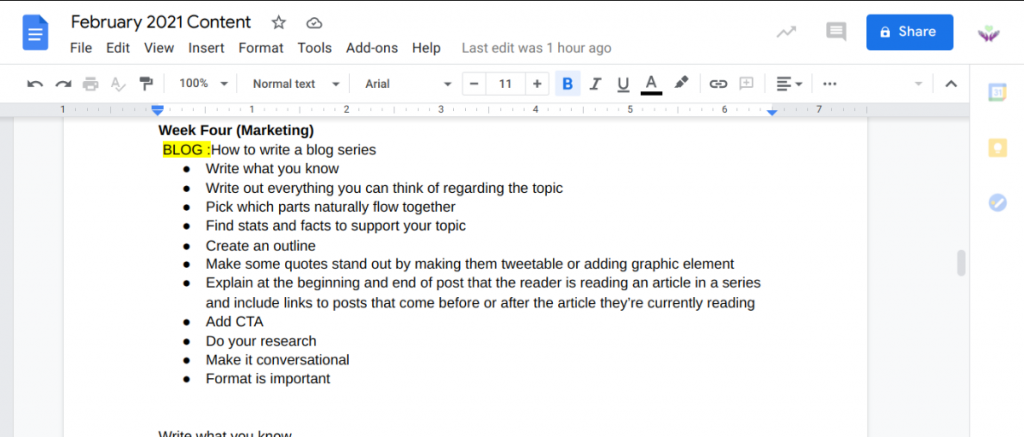Build credibility and establish yourself as a thought leader by creating your own blog series. A blog series is an easy way to educate your audience and provides them with a doorway to your expertise. They help potential customers get to know you and if you produce enough of them or get lucky and create a viral piece (not an easy feat because millions of blog posts are published DAILY), they’ll bring sizable exposure to your business and brand.
Here our our best practices for creating blog series.
- Write what you know
- Write out everything you can think of regarding the topic
- Pick which parts naturally flow together
- Find stats and facts to support your topic
- Create an outline
- Make quote graphics and click to tweets
- Make it clear that each post is part of a series
- Add a Call-to-Action (CTA)
- Make it conversational
- Remember that format is important

Write what you know
You’ll have the most to say about the topics you’re most comfortable with. Bring your perspective on common knowledge, industry trends or your unpopular opinion about something. You can write a series of articles on a topic you’re unfamiliar with (given you do the proper research) but chances are you’ll be more fulfilled expounding on things you enjoy. Talk about what you know best.
Plan it out
Start by writing out everything you can think of regarding the topic and we mean everything. It’s better to have too much information to work with than not enough.
This our initial list of everything. We ended keeping most of what you see.

For example, let’s say you wanted to do a blog series about cars (not the Pixar movie) but actual automobiles. You might start out by jotting down how you became interested in cars yourself, what was your first car, unusual facts people may not about cars, their history, most popular cars in your state or continent, foreign cars, luxury cars, and maybe even an expose on Pimp My Ride but you get the picture. Write out everything you can think of first and sort it out later.
Pick which parts naturally flow together
Once your brain dump is complete, connect the dots. Going back to our cars example, how you became interested in cars, what was your first car and unusual facts people may not about cars flow naturally together and could be labeled as part one of your series. In part two you may go into history, makes and models and vehicle popularity by continent. If your series is three parts, you could make the final post about oddities or miscellaneous information with cars such as the Pimp My Ride era.
Find stats and facts to support your topic
Do your research. Get updates on industry trends. Echo thought leaders you align with. Give facts. Your series should be a majority of your voice but should include some stats and facts about your topic of interest. This will make your series meatier and help you look more connected to your industry when you highlight your peers and incorporate data to into your writings. Do your best to educate your readers versus feeding them fluff throughout the series.
Create an outline
Writing out everything you can think of is to get what’s in your head out of your head. Connecting the dots helps you to see similarities in your ideas and what flows naturally into other topics. Creating an outline will help you structure your ideas and will keep you on track when you sit down to publish your series.
Make accompanying graphics

Use your preferred design tool to create pull-out quotes and graphics. We use Canva. It’s awesome and super user-friendly. These could be some of the
stats you find and the most poignant points in your series you want your reader to remember. You can make parts of your series tweetable by creating a free Click to Tweet account.
Explain that it’s a series
People won’t necessarily read your series in order and in the event they don’t, make it clear at the beginning what section of the series the reader landed on.
This can be achieved by saying something like This article is part of a 3-Part series on _________. if it’s the first post. If it’s the second post, include the same sentence with this addition To read part one of the series, click here. Do the same thing to point people back to the other connected pieces.
Word of caution, you can create a series with more than three parts but don’t go over seven. After that, you’ll be entering research paper territory and most people won’t follow your content that far down.
Add a Call-to-Action
Your blog series needs a call to action at the end of every post. This could be a lead magnet download, a quiz or the link to the next part of the series. Direct your reader to what you want them to once they consume your content.
Make it conversational
This isn’t an essay or a research paper. Blogs should be skimmable and light in tone. Write them as if you were having a conversation with the reader. Long paragraphs in blogs are hard on the eyes and will bounce readers off your page.
Format is important
For one thing, 50% of all content is consumed from mobile devices, so any content you create should automatically be optimized for mobile viewing. This goes back to what we said about making your blog skimmable. This means the reader should be able to get the gist of your piece without reading it in its entirety. This can be done by:
- Add subheadings
- Insert one space between sentences and two spaces between paragraphs (depending on your website and design this can stop your text from being too close together).
- Include pictures and video to break up the text
No one wants to read a page of single-spaced, text-only, poorly formatted content. We want pizazz.

In other words, make your blog visually appealing.
These are best practices to building credibility and establishing yourself as a thought leader through blog series. For more content ideas and inspiration, follow our Instagram account HERE.

